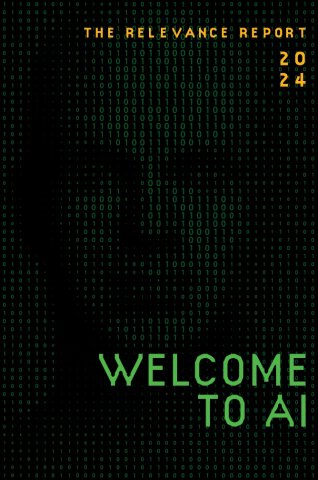
As a professional communicator and educator at the University of Southern California (USC), I’ve witnessed firsthand the ascendance of artificial intelligence in our industry. The USC Annenberg Center for Public Relations’ 2024 Relevance Report resounds this sentiment, positioning AI not as a futuristic concept but an indispensable asset in today’s marketing landscape.
Integrating AI into marketing goes beyond mere automation of tasks; it’s about harnessing the power of advanced data analytics, personalized customer experiences, and predictive insights to forge stronger connections with audiences. As AI continues to evolve, its role in shaping consumer engagement and brand narratives is becoming more pronounced, making it an essential element for any forward-thinking marketing strategy.
AI’s Journey in Communications:
Drawing from my experiences, I see AI’s journey in communications as akin to a “Hero’s” journey. Initially, it started with exploration where other early adopters and I began experimenting with essential AI tools like automated customer service chatbots and simple data analysis programs. These initial steps were crucial in building a foundation for more sophisticated applications.
As the journey progressed, AI faced (and continues to face) numerous challenges. These include problems like ensuring accuracy and safeguarding data security and complex challenges like navigating complicated ethical considerations. These challenges test and push the boundaries of AI’s capabilities, leading to significant improvements and innovations. For instance, advancements in natural language processing have enabled AI to understand and generate human-like text, transforming how brands communicate with their audiences.
The current phase of AI’s journey in communications is marked by its integration into strategic decision-making processes. AI now plays a pivotal role in understanding consumer behavior, optimizing marketing campaigns, and crafting compelling narratives through generative AI. This phase is characterized by a deeper integration of AI, where it’s not just a tool but a partner in the creative and strategic process.
AI’s Evolution and Impact on Communications Strategies:
As highlighted by experts like Microsoft’s Frank X. Shaw, the evolution of AI demonstrates that embracing AI in communications is not just about adopting new tools; it requires a blend of experimentation, urgency, and a willingness to drive cultural change. This dynamic array of AI tools is reshaping how we communicate, offering opportunities for more engaging, targeted, and impactful interactions. AI has become instrumental in understanding audience behaviors, predicting trends, and crafting messages that resonate more effectively. This evolution signifies a shift from traditional communication methods to more agile, data-driven, and AI-enhanced approaches.
The Need for Interdisciplinary Talent:
The integration of AI in communications highlights the need for talent that transcends the traditional skill sets. The modern communication landscape demands professionals who are not just tech-savvy but also adept at storytelling and creative thinking, capable of bridging various disciplines. These professionals must link with various disciplines, combining technical knowledge of AI with an understanding of human psychology, narrative techniques, and strategic thinking. This interdisciplinary approach is essential for effectively leveraging AI in communications, ensuring that technology enhances, rather than replaces, the human element in storytelling and audience engagement.
AI’s Role in Shaping Communications Industry:
Generative AI is revolutionizing the communications industry by offering new ways to create and distribute content. Its role extends beyond traditional automation, impacting corporate reputation and creative processes. AI tools can generate drafts, suggest creative ideas, and predict audience responses, allowing for a more dynamic and responsive communication approach. This has led to a shift in the industry, where AI is not just a tool but a partner in the creative process, enabling organizations to explore new frontiers in communication and maintain relevance in a rapidly changing digital landscape.
Predictive Analytics in Crisis Communications:
From a strategic standpoint, AI’s role in predictive analytics marks a significant advancement in crisis communications. Moving beyond reactive methods, AI enables organizations to anticipate potential crises and prepare strategies in advance. This proactive approach is transformative, allowing for swifter and more effective responses. AI-driven predictive analytics can monitor trends, forecast public reactions, and suggest strategic messaging to mitigate crises. This capability has fundamentally altered the approach to crisis communications, shifting from a traditionally reactive stance to one that is anticipatory and strategic.
Adapting to AI-Driven Media Landscape:
The report resonates with my belief that adapting to an AI-driven media landscape requires a significant shift in our operational structures. Effective messaging in this new media landscape demands agility, and a readiness to engage with diverse stakeholder needs in real-time.
AI tools aid in analyzing vast amounts of data from various channels, enabling communicators to quickly adapt their strategies to changing audience dynamics. This adaptability is crucial for staying relevant and effective in an environment where media consumption patterns and communication channels constantly evolve.
Redefining Roles and Opportunities in the AI Era:
In the AI era, the roles and opportunities for communicators are being redefined. AI is not just about automating routine tasks; it’s about enriching the communication process with insights and efficiencies that were previously unattainable. This shift presents an opportunity to mentor the next generation of communicators, emphasizing the importance of critical thinking and strategic insights. Professionals must be adept at interpreting AI-generated data, using it to inform more nuanced and effective communication strategies, and going beyond traditional roles to embrace a more integrated and analytical approach.
AI as Audience and Partner:
I’ve observed a profound shift in the dual role of AI, both as an audience and a partner. Communicators must now craft messages that appeal to human emotions, which are also optimized for machine learning algorithms. This dual focus requires a unique blend of scientific understanding and creative insight. AI, as an audience, means creating easily interpretable and valuable content for AI-driven platforms. At the same time, AI, as a partner, involves leveraging AI’s capabilities to enhance the creativity and effectiveness of communication campaigns.
Ethical Implications and Challenges:
Perhaps the most important thing I write in this article is this: integrating AI into communications brings a wave of innovation and introduces a broad spectrum of ethical considerations. The issues at the forefront include bias in AI algorithms and the imperative for transparency. Bias in AI, whether stemming from data or design, can lead to skewed and unjust outcomes, potentially amplifying societal inequalities. This is particularly concerning in communications, where biased algorithms could disseminate skewed information, affecting public opinion and discourse. Transparency is equally crucial, as stakeholders need to understand how AI-driven decisions are made. This understanding is key to building trust in AI systems and ensuring accountability in their outputs.
Fellow educators play a pivotal role in shaping the ethical use of AI in communications. We must lead by example, integrating ethical considerations into the curriculum and teaching future communicators about the potential biases in AI and the broader societal implications of AI deployment. It also means encouraging critical thinking and ethical decision-making in applying AI in communications.
In addition, there is a need for ongoing dialogue and continuous evaluation of AI’s impact on society. Establishing guidelines for responsible AI use is just the beginning. These guidelines must be dynamic, evolving with advancements in technology and changes in societal values. Regular assessments of AI’s impact are crucial to ensure its deployment aligns with ethical standards and promotes the greater good. Such evaluations can help identify unforeseen consequences of AI’s use and inform adjustments to strategies and policies, ensuring that AI’s role in communications continues to be beneficial and ethically responsible.
The USC 2024 Relevance Report serves as a clarion call for the communications industry. As AI evolves, it demands technological adaptation and a paradigm shift in our approach – embracing agility, fostering innovation, and maintaining a keen eye on ethical implications. As communicators, it’s our responsibility to navigate this shift, ensuring we harness AI’s potential responsibly and creatively.
Access the full report here and learn how to navigate this crucial shift, ensuring we harness AI’s potential responsibly and creatively.






